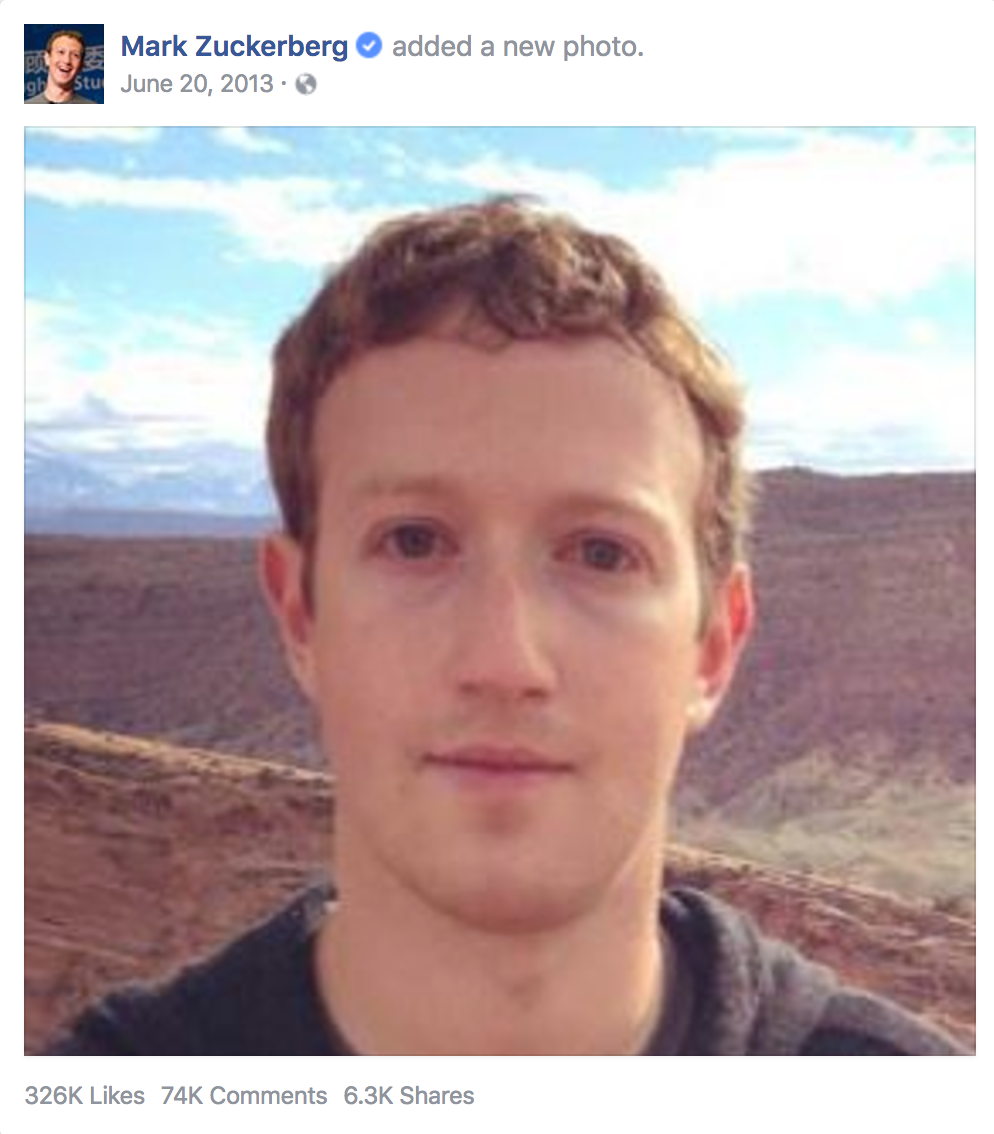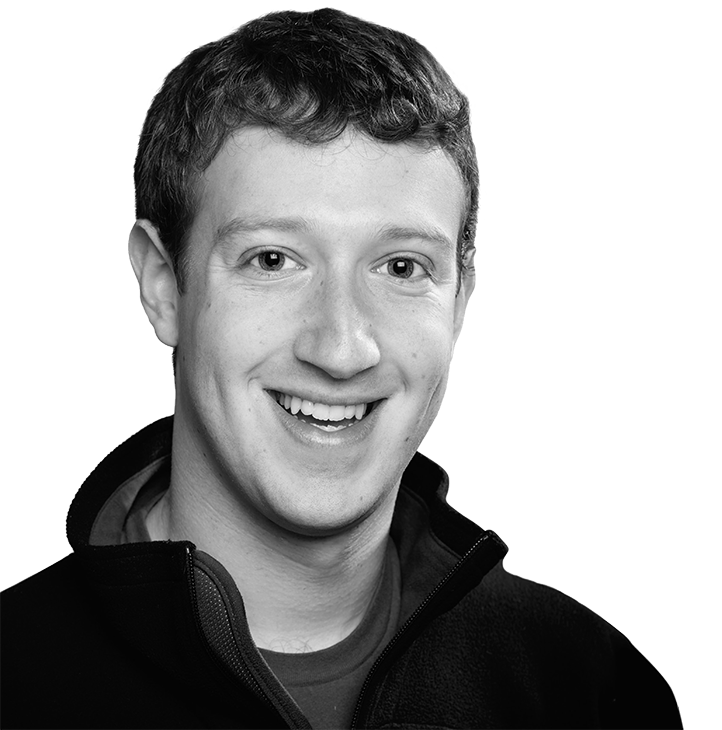
Source: Facebook - Mark Zuckerberg (June 20, 2013)
Mark Zuckerberg's Significant Insignificance



Here is Mark Zuckerberg, our current tech dude of the moment who presents himself neither as a businessman or a thinker, but as a Normal Guy. You can just see the glimpse of his signature gray t-shirt beneath his matching gray hoodie. He is neither smiling or frowning, and the picture is taken close enough to his face that we are unsure of whether he took the photo himself, if someone else took it, if there were other people originally in the picture. Was the picture planned, or was it a spur of the moment snap? Did he upload it on the spot, or did he upload it at home, or in his office at Facebook HQ? Though this seems unlikely, the image of a spontaneous upload by a major world figure is alluring. We can see the slope of his shoulders and his neck, but otherwise he is bodiless and handless, his pose lacking any physical agency. Yet he looks directly into the camera, and us. It is maddeningly neutral.
The scenery behind him is nondescript—there are no landmarks or recognizable signs to clue us into his exact GPS location (we may, of course, guess), and there are no signs of technology or human imprint of any kind. He stares at us not from a silicon valley office, nor from his home, but from a sprawling dead landscape that is so flat it seems to signify eternity. This was his profile picture for approximately two weeks. Why even keep it in his album archives?
You may have noticed that this picture is different than current images of Zuckerberg. Uploaded on the summer solstice of 2013 as his profile picture, the face of Facebook loomed at us from the outdoors, extracted straight from his smartphone. Now he has hired a professional photographer, Charles Ommanney, to photograph him as he tours the United States. Gone are the days of his unprofessional photos and thoughtless profile pictures. But this self administered picture on unconquered land serves as a foreshadowing to Facebook’s future endeavors. This was a year before we discovered Facebook’s studies to observe and administer ads that would affect our moods and hack our emotions in 2014. It would be four years until Facebook would be accused of enabling the fake news circuit and propelling targeted data that affected the 2016 presidential election. Facebook is not just a website like the ones that came before, which stayed stagnant until consumers grew bored and moved on. With its constant updates and algorithmic strategies to infiltrate user’s information, it unleashes onto untouched land and like nature, will continually evolve. The message one may construe from this picture is that Zuck, and by extension all of Facebook, is everywhere. If we did not realize that in 2013, we certainly do now.
Every tech leader has an identifiable persona immortalized in pictures. For Bill Gates it was his clunky glasses, neatly combed hair, and sweater vest worn over a collared shirt and tie holding up an early version of Microsoft Windows software that we remember. His uniform over time has not changed much—Google Images is scattered with various headshots of an older Gates, usually looking at the camera in what appear to be stilted professionally taken headshots. It is a tried and true formula of every CEO, businessman, and professional that has signified the position of authority. Like our bosses on LinkedIn. Then there was Steve Jobs, with his signature black turtleneck and light wash jeans on the cover of Walter Isaacson’s biography looking like a 21st Century Godard character. In the photo, taken by Albert Watson, he is looking directly into the camera, hand in an empty fist with the thumb pressed thoughtfully to his chin. In other pictures, that empty fist is filled by an apple product, the newest iPhone propped up by his thumb.
This image is… youthful, indistinguishable from the profile pictures of many men I grew up with. There is little difference between this picture of Zuck and a profile picture of a boy on my college improv team. Rather than a CEO, he appears on the other side of the spectrum of tech influence, as a hacker. Most photos of him before 2016 look similar—non-threatening and approachable, a slightly upgraded Myspace Tom. A self-administered entrepreneur as opposed to a major CEO, and a transient one. This picture is not early Mark Zuckerberg (duh, he’s been around since 2004) but it is earlier Zuck, pre-children, pre-marriage, and pre-politics.
His image of neutrality is, of course, deceiving. Zuckerberg’s t-shirts, as we have all read by now, cost $400 each and are stocked in bulk. Large sums of money spent on clothes used to distinguish the wealthy from the non-wealthy, now it flattens it out. As with the pastiche of normcore, he subverts the class system and their social signifiers by appropriating them. Money becomes invisible, threaded into the finer stitching. Much like his uniform is inspired by the clothing of broke teenage slackers, so too is his appearance as a CEO. He presents himself on a self made platform where he can interact with his users, or at least, where users feel like they can interact with him. We don’t see his body, even his hands, because unlike Jobs or Gates, who often held up their products for pictures, Zuck has nothing to hold up. Facebook as a technology and system is too vast, too connected to other parts of the internet to be defined. Rather than presenting himself as a figure or celebrity in this picture, he presents himself as a face on a screen that is both approachable and terrifyingly distant. Is this a controlled image, or a haphazardly uploaded photo? The image of Zuckerberg’s face, bodiless and omniscient, looms at us blankly, a bit creepily, and with little dignity. As one Facebook user (thousands write to him everyday) commented on the picture “your eyes look like they’ve been hacked by an electromagnetic pulse machine ;).” Even his face appears to have a claylike appearance, as though we are gazing on a half-formed human subject.
Rather than inventing, Facebook infiltrates the internet and our data by this very same image of neutrality. In a recent post atoning for his previous comment calling the accusation of Facebook’s intervention in the 2016 election “crazy,” he wrote, “Trump says Facebook is against him. Liberals say we helped Trump. Both sides are upset about ideas and content they don’t like. That’s what running a platform for all ideas looks like.” His claim of Facebook’s neutrality matches the long neutral ethos of his web presence. Meekness is Zuckerberg’s deliberate image, much like the mission of Facebook itself. While the CEO took a laissez-faire approach to the social media site’s spreading of fake news, libelous political advertisements, and dummy accounts used to target undecided voters, he was using his own body to reflect those ideals as well. Just as many users were ignorant of Facebook’s impact of what they saw and read, this picture misleads us into believing Zuck is a neutral, banal presence in the tech world.
The appearance of the hierarchies of power looks different these days. Instead of coming at us from a position of notable influence that separates himself from other users, he comes at us from within. This picture represents how fully integrated he appears amongst other users, much like the essence of Facebook’s power. While his plain $400 t-shirts are indecipherable from other t-shirts, Facebook’s algorithms also appear organic instead of strategic. While his clothing choice represents invisible money, so does the curated content we see on our feeds. The physical appearance of money has disintegrated, for we can no longer be sure about the difference between content delivered organically versus content produced by the deep pockets of those in power. Zuck’s appearance in this picture (and all pictures) represents a shifting form of commodity exchange on social media. This, his most underwhelming profile picture, serves as a reminder that often what we mistake as neutral is a deliberate naturalization of monetary power. And if monetary influence is a direct affect of this mission of a centrist and anodyne platform, then we can surmise that such a platform cannot, as we have long suspected, be a democratic or neutral outlet.
This may not be one of the pictures we will remember him by. He could delete the picture tomorrow and it would be erased from our memory (many of his earlier profile pictures seem to be). But we should remember, that before candid pictures of him walking his dog, exercising with his daughter, feeding a calf in Ohio with a little milk bottle, or leaning on a beige table in a beige room live streaming his solution to Russian interference, there was this rogue and sporadic picture that attempted to represent a democratic vision of what a CEO could be. And Zuck wants us to remember too. Because unlike the tech innovators that came before him, he does not have a solid image or point of view. His persona is malleable, forever morphing to accommodate his followers. We’re watching him mature just as we’ve watched Facebook solidify. The progression of his life captured online—his marriage and the birth of his two children—matches the progression of Facebook into a huge empire that owns our data. It is too soon in Zuckerberg’s life to predict whether there will ever be one iconic image to symbolize his whole career, but I’d wager to say there will not, because much like the evolution of Facebook, his image is a gradual becoming.
